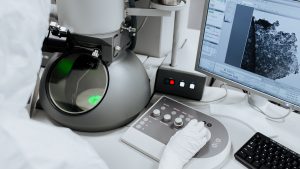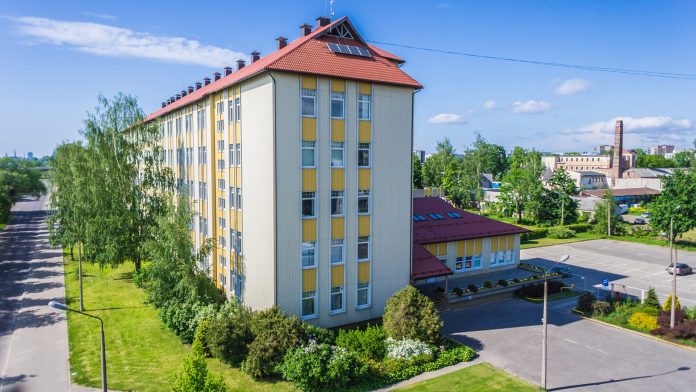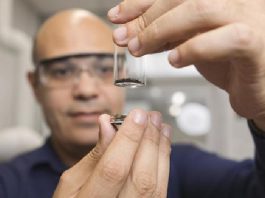The University of Latvia’s Institute of Solid State Physics is bringing the future closer through scientific research, encouraging young scientists and business ventures alike to develop the technologies of tomorrow.
The Institute of Solid State Physics, University of Latvia (ISSP UL) is an independent legal entity founded by the University of Latvia. It is an internationally recognised leader with 46 years of experience in materials science and cross-disciplinary topics in Latvia. The Institute employs more than 100 Doctors of Science, conducting internationally competitive research, educating students, and offering innovative solutions for industrial needs.
The ISSP UL cares for education and attracts highly qualified scientific staff. The master’s degree study programme, developed in co-operation with the Faculty of Physics, Mathematics and Optometry, the University of Latvia, is the basis for building young people’s knowledge and industrial competitiveness in the future.
The Institute actively co-operates with more than 100 international scientific organisations and universities around the world to raise the qualifications of students and scientists and attract entrepreneurs and investors.
ISSP UL elaborates an average of 50 scientific projects per year. About one-third of the projects are carried out jointly with companies.
Along with progress in scientific research, the ISSP UL has developed solid collaboration with high-level innovation industries in Latvia. Technological and scientific research outcomes of the ISSP UL are transferred into several spin-off companies.
Major application-oriented priority directions of the ISSP UL’s activities:
- Photonics;
- Thin films, low dimensional (0D, 1D, 2D) structures and sensors;
- Energetics; and
- Medical technologies (diagnostics) and microfluidics.
ISSP UL’s four priority research directions have been strategically established to increase strong international scientific capacity and to represent the most current trends of material science, reflecting development in terms of scientific results, available infrastructure, and ongoing collaboration with scientific organisations and industry.
Photonics
The direction is related to fundamental scientific research in non-linear optics and the study of advanced optical materials for organic and non-organic materials to develop polymer photonic elements, optical fibre-based devices, and new light sources and displays.
The Laboratory of Organic Materials conducts fundamental and applied research on organic molecules, materials, and their structures to build knowledge about the relationship between structure and properties in organic materials for next-generation electronics and photonics.
The Micro and Nanodevices Laboratory performs R&D and fabrication of various micro-devices and nanostructures: sensors, transistors, etc. Industrial experience in the fields of photonics, semiconductors, and microfluidics.
The Laboratory of Visual Perception researches the optical quality of different optical systems, adaptive optics, wave-front phase retrieval, various light sources and their influence on visual perception, and different visual stimuli designed for studies on visual psychophysics. The laboratory combines knowledge in materials science, wave optics, vision science and optometry.
The Laboratory of Optical Materials studies persistent luminescence, the interaction of ionising radiation with crystalline, ceramic and glass-like structures, and performs research on optical fibres and ultraviolet optics.
Thin films, low dimensional (0D, 1D, 2D) structures and sensors
Applications related to this direction are coatings, thin films for nanoelectronics, antiviral coatings, and chromogenic multilayer structures for smart windows. The dimensional scaling of materials dramatically modifies their electrical, thermal, mechanical, and magnetic properties and their material-property relationship, which in turn alters the physical behaviour of nanoscale electronic and photonic devices. There are significant challenges related to understanding and controlling material properties at the nanoscale and integrating nanomaterials into hybrid systems at advanced technology nodes.
The Thin Films Laboratory provides a thin film deposition service for a wide variety of inorganic materials, using different deposition techniques, including the PVD vacuum multifunctional R&D cluster SAF25/50, the magnetron sputtering G500M cluster including High Power Impulse Magnetron Sputtering (HiPIMS), as well as PLD, MOCVD and ALD.
The EXAFS Spectroscopy Laboratory studies the structure of various materials using synchrotron radiation X-ray absorption spectroscopy.
The Laboratory of Spectroscopy is one of the largest and best-equipped laboratories at the ISSP UL. It combines various research techniques related to optical, electron and magnetic spectroscopy.
The Microscopy Laboratory focuses on studying material structures, morphology, and composition using modern experimental and theoretical methods. This is, to a significant degree, a method-based laboratory providing full-scale services to other research laboratories.
The Laboratory of Computer Modelling of Electronic Structure of Solids performs large-scale ab initio computer simulations on advanced materials, their surfaces, interfaces, and nanostructures.
Energetics
This covers many things, including fuel cells, photovoltaics, thin film batteries, lithium-ion and potassium-ion batteries, supercapacitors, piezoelectric energy harvesters, lead-free ferroelectric ceramics for electromechanical actuators and energy harvesting, hydrogen generation, hydrogen as energy storage technologies with a lower environmental footprint, thermoelectric generators, and advanced functional and construction materials for thermonuclear fusion.
The Energy Materials Laboratory studies cathode materials and anode materials for Li-ion and Na-ion batteries, materials, and technologies for producing hydrogen in electrolysis or photoelectrolysis in biomass dark fermentation processes and its storage in metal hydrides and nanostructured composite materials.
The Laboratory of Optical Materials conducts comprehensive scientific research on ferroelectric solid solutions of perovskite structure, the technology of transparent ceramics and its application in electronic and photonic devices. The laboratory focuses on the R&D of lead-free ferroelectric ceramics and thick films.

Medical technologies and microfluidics
The Micro and Nanodevices Laboratory performs R&D and fabrication of various microdevices and nanostructures: Microfluidic devices, sensors, transistors, etc. The biotechnology spin-off Cellbox Labs is developing organs-on-a-chip that could help pharmaceutical companies test new drugs more efficiently. The Laboratory is also involved with cancer biomarker separation and detection. Other key laboratories of ISSP UL involved in developing this direction:
- Laboratory of Thin Films;
- Laboratory of Spectroscopy; and
- Laboratory of Computer Modelling of Electronic Structure of Solids.
Education is key to developing the regional scientific industry
Sustainability is highly dependent on the next generation, who will take on the mantle of scientific enthusiasm and maintain it in ongoing research and continuous development. Education is identified as a key to developing a regional high-tech industry by providing well-educated, competent, and skilled scientists, engineers, and entrepreneurs. Since its foundation, ISSP UL has been actively teaching at the bachelor, master, and doctoral levels, with close links to scientific work at the Institute.
A significant share of the diploma works defended at the University of Latvia is carried out here. A number of scientists at ISSP UL are involved in teaching and administering both bachelor’s and master’s programmes in physics. This engagement is of vital importance for the recruitment of students and young scientists to the ISSP UL.
The developed programmes are more cross-disciplinary and application-oriented and aim to produce well-educated, competent, and skilful scientists, engineers, and entrepreneurs. The courses of the new programmes have been accepted into the curriculum of the Department of Physics, University of Latvia, and have gained tremendous popularity among the students.
The objectives of the modifications are elaborated to achieve scientific excellence of strategic relevance for ISSP UL and projected industrial needs. Hence, the compulsory part of the programme is modern, extensive, and comprehensive to attract students with different backgrounds in physics and with a broad interest ranging from science to innovation and development. Both master’s and doctoral programmes are open to international students, as courses may also be taught in English.
The master’s programme includes general topics on quantum physics, solid-state physics, photonics, nanomaterials, electronics, and nanotechnologies. Specific topics on the design of nanosemiconductor devices, synthesis and characterisation of thin films, nanoceramics and spectroscopy are also covered. Courses on the management of innovation processes and ethics have been established, too.
The doctoral programme was developed in co-operation between ISSP UL and RISE scientists and professors from the KTH. It consists of studies with regular lectures in the existing doctoral programme, ‘Functional Materials and Nanotechnologies’, based at the ISSP UL. The programme’s content was upgraded to include more elements of applied sciences, innovation, and entrepreneurship.
Another essential need for scientific development is attracting the next generation of skilful and passionate young students to Science, Technology, Engineering and Maths (STEM) disciplines, encouraging school youths to study exact sciences and continue their professional development in academia and industry. Therefore, ISSP UL actively participates in conferences and exhibitions devoted to school youth and students in higher education and research institutions, awarding student grants at ISSP UL, organising excursions for school students, and giving lectures at schools and during career days. Each year, the Institute provides an opportunity to shadow scientists during Job Shadow Day and welcomes children of all ages to the Researcher’s Night. For 15 years, the Institute has been organising a Solar Cup competition for school youth and providing possibilities to conduct scientific research projects for secondary school students.
A collaborative innovation platform
ISSP UL created the industry collaboration platform Materize in 2018 to establish a single point of contact where science can benefit businesses. The platform provides access to the expertise and resources of the Institute. Accessible research and an innovative environment make an excellent combination for local and international companies to develop cutting-edge ideas and meet the needs of the industry.
The collaboration is straightforward and transparent within the framework of Materize: Business-customer-tailored processes, clear information for the industry, and a simple approach to ISSP UL competencies and infrastructure.
Materize is providing ISSP UL scientific services in the following areas:
- Materials for electronics and photonics;
- Solutions for energy storage and hydrogen;
- Coating development and testing;
- Nanomaterial development and synthesis;
- Battery material synthesis and cell cycling;
- OLED full-cycle development;
- Modern methods of material characterisation;
- Theoretical modelling and design;
- Prototyping and small-scale production;
- Novel sensor material development; and
- Protection of Intellectual Property.
By drawing on the experience of ISSP UL, Materize works alongside the industry to develop internationally competitive research innovations in the fields of thin films, electronics, light emitters, fibre optics, sensors, and photonics, which have applications ranging from ICT to energy harvesting and storage.
The Institute has already gained experience in co-operation with international market players in high-technology areas, such as GroGlass, Sidrabe, NacoTechnologies, Baltic3D, LightGuideOptics International, EuroLCDs, CeramOptec, RD Alfa Microelectronics, Dinex Latvia, Giraffe360, Latvenergo, Canatu OU, and others.
The Excellence Centre of Advanced MAterial Research and Technology Transfer (CAMART²)
One of the ten projects to receive funding through the WIDESPREAD 1- 2014: Teaming competition was CAMART2, the biggest project in the history of Latvian science at the time. This was launched at a ceremony attended by representatives of the European Commission, Latvian government officials, foreign co-operation partners and guests, as well as the project’s orchestrators, i.e., the employees of the Institute of Solid State Physics, University of Latvia. The project’s objective is to strengthen the position of the Institute and the Latvian state within the European science sector through the development of the centre into a regional institution of European renown in the field of materials science and technology transfer.
The strengths of the CAMART² project are the high qualifications of the scientists involved, a firm plan for passing on this knowledge and experience, and encouraging mutual collaboration between the academic and business sectors. This project has all the characteristics required to make it exemplary: High-level science, the potential for innovation, the business sector, new enterprises, and powerful partnerships, as well as a convincing management structure, which is vital for a project of this scale.
During its implementation, the project has facilitated the formation of a more comprehensive innovation and technology transfer ecosystem in the realm of research into modern materials and the use of such materials in innovative products. Thus, it has already paved the way for the launch of new advanced technology and high-added-value manufacturing companies. This effort epitomises the ends for which Teaming was established.
CAMART2’s aim is to establish the ISSP UL as a significant centre of modern materials research and technology transfer in Latvia and the Baltic Sea region. The material science centre was established with world-class innovation and technology transfer experts and project partners – the Swedish Royal Institute of Technology (KTH) and the Research Institutes of Sweden (RISE).
Since 2017, using the resources of CAMART2, ISSP UL has implemented an innovation development system to translate the new knowledge from fundamental research into real innovation potential, thereby making it disruptive. A new approach was required to change the mindset and realise that fundamental research should also be directed towards technological needs and industrial challenges. The established system has contributed to the development of advanced, unique, and commercialisable technologies.
Please note, this article will also appear in the seventeenth edition of our quarterly publication.









